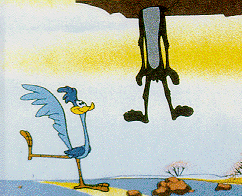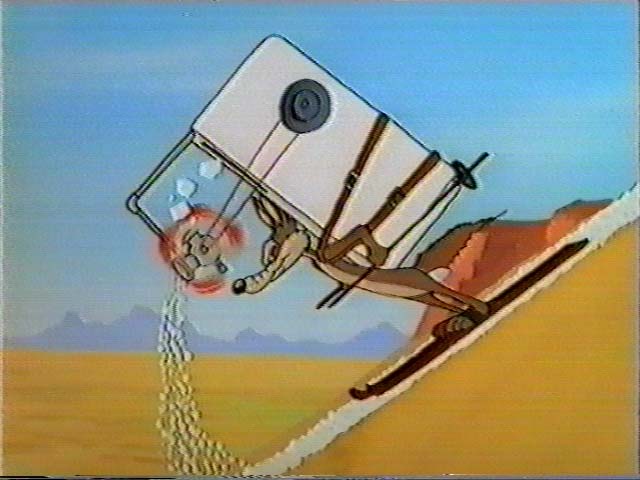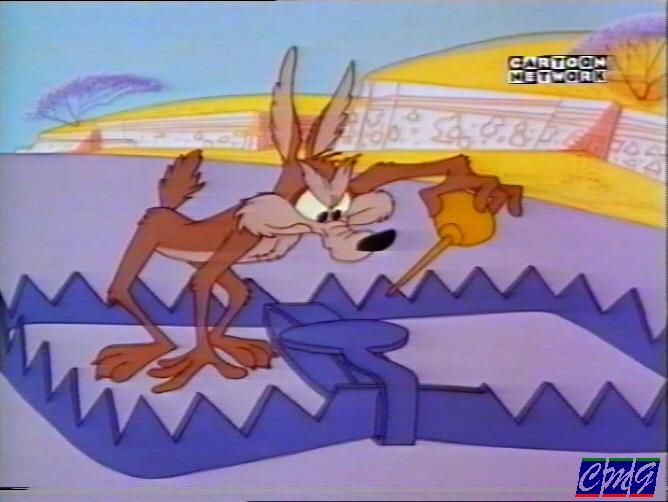|
|

Road Runner and Wile E. Coyote Cartoon
The Road Runner & Wyle Coyote cartoons are a series of Looney Tunes
cartoons created by Chuck Jones for Warner Brothers.
The Roadrunner shorts are very simple in their premise: the Road
Runner, a flightless cartoon bird (loosely based on a real bird,
the Greater Roadrunner), is chased down the highways of the
Southwestern United States by a hungry coyote, named Wile E.
Coyote (a pun on "wily coyote"). Despite numerous clever
attempts, the coyote never catches or kills the Road Runner, and
all of his elaborate schemes end up injuring himself in humorous
instances of highly exaggerated cartoon slapstick violence.

There is never any dialogue save the Road Runner's "beep-beep"
but the two characters do sometimes communicate by holding up
signs to each other, the audience, or the cartoonist (though both
these rules were broken later). Another key element is that while
Wile E. is the aggressor in this series, he and his hopelessly
futile efforts are the focus of the audience's sympathy as well
as virtually all of the humor. Wile E. seems doomed,
forever to try but never to succeed.
Typically at the start of each episode, during a chase sequence,
the action pauses, to show us the apparent Latin names of Road
Runner (as of Homo sapiens is the Latin name of the human
species), and Wile E. Coyote, usually emphasising the former's
speed, and the latter's hunger. For example, in the episode
Lickety Splat, they have Latin names "Fastius Tasty-us", and
"Apetitius Giganticus". These names changed from episode to
episode.

The Acme Corporation
Wile E. Coyote often obtains complex and ludicrous devices (Rube
Goldberg machines) from a mail-order company, the fictitious Acme
Corporation, which he hopes will help him catch the Road Runner.
The devices invariably backfire in improbable and spectacular
ways. The coyote usually ends up burnt to a crisp, squashed flat,
or at the bottom of a ravine. How the coyote acquires these
products without any money is never explained, nor is any
distinction made between equipment defects or operator error.

The company name was likely chosen for irony (acme means the
highest point, as of achievement or development). The expansion A
Company that Makes Everything is a backronym.
Among the products produced by the Acme Corporation are:
Acme catapults
Acme earthquake pills
Acme rocket sled kits
Acme portable holes
Acme Burmese tiger trap kit
Acme jet-propelled roller skates
Acme super leg vitamins

Like in other cartoons, the Road Runner and the Coyote follow the
laws of cartoon physics. For example, the Road Runner has the
ability to enter painted caves, which the Coyote cannot.
Sometimes the Coyote is allowed to hang in midair until he
realizes that he is about to plummet into a chasm. The Coyote can
overtake rocks which fell before him, and end up being squashed
by them.
Road Runner & Wyle E. Coyote Rules
In his book Chuck Amuck, Chuck Jones explains some of the rules
the artists followed in making the Coyote-Road Runner series:
The Road Runner cannot harm the Coyote except by going
"Beep-beep!"
No outside force can harm the Coyote - only his own ineptitude or
the failure of the Acme products.
The Coyote could stop any time - if he were not a fanatic.
No dialogue ever, except "Beep - beep!" The Coyote may, however,
speak to the audience through wooden signs that he holds up.
The Road Runner must stay on the road - otherwise, logically, he
would not be called Road Runner.
All action must be confined to the natural environment of the two
characters - the southwest American desert.
All materials, tools, weapons, or mechanical conveniences must be
obtained from the Acme Corporation.
Whenever possible, make gravity the Coyote's greatest enemy.
The Coyote is always more humiliated than harmed by his failures.
There was also a tenth and more unofficial rule
The Sympathy of the audience must lie with the Coyote.

The Road Runner and coyote appeared again after the end of the
original Chuck Jones productions in 1964.
A series of 11 cartoons were done later in the 1960s by David
DePatie and Friz Freleng, animators of the Pink Panther cartoons.
Post-Chuck Jones cartoons allowed the coyote to speak, and he
once (in the episode called "Soup or Sonic") had the Road Runner
in his grasp but thanks to a gag involving a tunnel that got
smaller and narrower as he went through it Coyote is only a few
inches tall and can only grab the Road Runner's leg - at which
point he holds up a sign that reads "Okay, wise guys, you always
wanted me to catch him. Now what do I do?".
Wile E. Coyote has also unsuccessfully attempted to catch and eat
Bugs Bunny in another series of cartoons. In these cartoons, the
Coyote does speak with a smooth, generic East Coast upper class
accent -- provided by Mel Blanc, of course:
Quote: (to himself:) "Wile E. Coyote. Su-u-u-uper Ge-e-enius."
In one short, Bugs--with the help of amphetamines--even sits in
for Road-Runner, who has "sprained a giblet", and carries out the
duties of outsmarting the hungry scavenger.
In another, Wile E. lectures two young TV-watching children about
the edible parts of a Road-Runner attempting to explain his
somewhat irrational obsession with catching it, with help from an
illustrated chart showing each section of the bird and its
flavor.
In another series of Warner Bros. cartoons, the character design
of Wile E. Coyote was copied and renamed "Ralph Wolf." In this
series, Ralph continually attempted to steal sheep from a flock
being guarded by the eternally vigilant Sam Sheepdog. As with the
Road Runner series, Ralph Wolf used all sorts of wild inventions
and schemes to steal the sheep, but he was continually foiled by
the sheepdog. In a move seen by many as a satirical gag, Ralph
Wolf continually tried to steal the sheep not because he was a
fanatic (as Wile E. Coyote was), but because it was his job. At
the end of every cartoon, he and the sheepdog would stop what
they were doing, punch a timeclock, and go home for the day. The
most prominent difference between the coyote and the wolf, aside
from their locales, was that Wile E. had a black nose and Ralph
had a red nose.
In 2004, Wile E. appeared (along with Bugs Bunny and Daffy Duck)
in an AFLAC commercial, in which he is shown as being a prime
candidate for the company's services. Before he plummets, taking
the AFLAC duck with him, he holds up a sign reading "Ask About It
At Work" (one of AFLAC's taglines).
Road Runners and automobiles
The Plymouth Road Runner was a performance model of car produced
by the Plymouth division of Chrysler between 1968 and 1980. An
official licensee of Warner Brothers (paying $50,000 for the
privilege), the Road Runner used the image of the cartoon bird on
the sides.
General Motors used the Road Runner on its marketing campaign in
1985 for its Holden Barina in Australia. Even in 2004, 'Beep beep
Barina' is still known as a catchphrase by many Australians.
This article was derived fully or in part from an article on
Wikipedia.org - the free encyclopedia.
List of Famous Birds in
Myth, Books, Comics & Film
Index of
Looney Tunes Characters
|